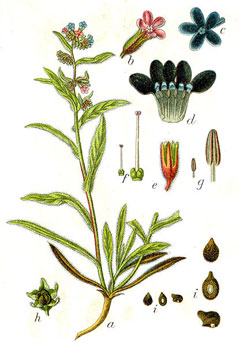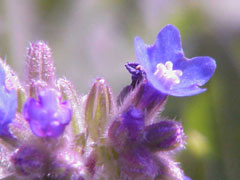 |
|
http://commons.wikimedia.org/wiki/File:Anchusa_officinalis_Sturm8.jpg |
 |
| http://www.biolib.de/ |
Translate this page:
Summary
Anchusa officinalis/ Alkanet or Common bugloss is a perennial usually found on roadsides, pastures and waste ground. It has edible leaves and flowers and minor medicinal and other uses.
Physical Characteristics

 Anchusa officinalis is a BIENNIAL/PERENNIAL growing to 0.6 m (2ft).
Anchusa officinalis is a BIENNIAL/PERENNIAL growing to 0.6 m (2ft).
See above for USDA hardiness. It is hardy to UK zone 5 and is not frost tender. It is in flower from June to October, and the seeds ripen from July to October. The species is hermaphrodite (has both male and female organs) and is pollinated by Bees.
It is noted for attracting wildlife.
Suitable for: light (sandy), medium (loamy) and heavy (clay) soils and prefers well-drained soil. Suitable pH: mildly acid, neutral and basic (mildly alkaline) soils. It cannot grow in the shade. It prefers moist soil.
UK Hardiness Map
US Hardiness Map
Synonyms
Plant Habitats
Cultivated Beds;
Edible Uses
Edible Parts: Flowers Leaves Shoots
Edible Uses: Colouring
Leaves and young shoots - cooked[9, 115, 166]. Used like spinach[2, 183]. Flowers - cooked or used as a garnish[183]. The red dye obtained from the roots can be used to colour oils and fats[105].
References More on Edible Uses
Medicinal Uses
Plants For A Future can not take any responsibility for any adverse effects from the use of plants. Always seek advice from a professional before using a plant medicinally.
Demulcent Expectorant Homeopathy
All parts of the plant are demulcent and expectorant[9]. They are used externally to treat cuts, bruises and phlebitis and internally to treat coughs and bronchial catarrh[9]. A homeopathic remedy is made from the plant[9]. It is used in the treatment of stomach and duodenal ulcers[9].
References More on Medicinal Uses
The Bookshop: Edible Plant Books
Our Latest books on Perennial Plants For Food Forests and Permaculture Gardens in paperback or digital formats.

Edible Tropical Plants
Food Forest Plants for Hotter Conditions: 250+ Plants For Tropical Food Forests & Permaculture Gardens.
More

Edible Temperate Plants
Plants for Your Food Forest: 500 Plants for Temperate Food Forests & Permaculture Gardens.
More

More Books
PFAF have eight books available in paperback and digital formats. Browse the shop for more information.
Shop Now
Other Uses
References More on Other Uses
Cultivation details
Succeeds in most soils, preferring a sunny position[1]. Prefers a fertile well-drained soil[111]. The flowers are a rich source of nectar and are very attractive to bees[1]. The dry leaves emit a rich musky fragrance, rather like wild strawberry leaves drying.
References Carbon Farming Information and Carbon Sequestration Information
Temperature Converter
Type a value in the Celsius field to convert the value to Fahrenheit:
Fahrenheit:
The PFAF Bookshop
Plants For A Future have a number of books available in paperback and digital form. Book titles include Edible Plants, Edible Perennials, Edible Trees,Edible Shrubs, Woodland Gardening, and Temperate Food Forest Plants. Our new book is Food Forest Plants For Hotter Conditions (Tropical and Sub-Tropical).
Shop Now
Plant Propagation
Seed - sow spring in pots of sandy soil[200]. An overnight drop in temperature helps germination[133]. The seed usually germinates in 1 - 4 weeks at 21°c[133]. When large enough to handle, prick the seedlings out into individual pots and plant them out in the summer. The seed can also be sown in an outdoor seed bed during July, transplanting the plants to their final positions during early autumn[245]. These plants will grow larger and flower earlier than those sown in spring.
Other Names
If available other names are mentioned here
Native Range
TEMPERATE ASIA: Turkey EUROPE: Denmark, Sweden (south), Austria, Switzerland, Czech Republic, Germany, Hungary, Netherlands, Poland, Slovakia, Russian Federation-European part (European part (west)), Belarus, Estonia, Lithuania, Latvia, Moldova, Ukraine, Albania, Bulgaria, Greece, Croatia, Italy, Romania, Serbia, Slovenia, Spain (Baleares), France (incl. Corsica)
Weed Potential
Right plant wrong place. We are currently updating this section.
Please note that a plant may be invasive in one area but may not in your area so it's worth checking.
This plant can be weedy or invasive. In the US: Oregon (common bugloss): ”B” designated weed/Quarantine and Washington a
Class B noxious weed/Noxious weed seed and plant quarantine.
Conservation Status
IUCN Red List of Threatened Plants Status : This taxon has not yet been assessed.

Growth: S = slow M = medium F = fast. Soil: L = light (sandy) M = medium H = heavy (clay). pH: A = acid N = neutral B = basic (alkaline). Shade: F = full shade S = semi-shade N = no shade. Moisture: D = dry M = Moist We = wet Wa = water.
Now available:
Food Forest Plants for Mediterranean Conditions
350+ Perennial Plants For Mediterranean and Drier Food Forests and Permaculture Gardens.
[Paperback and eBook]
This is the third in Plants For A Future's series of plant guides for food forests tailored to
specific climate zones. Following volumes on temperate and tropical ecosystems, this book focuses
on species suited to Mediterranean conditions—regions with hot, dry summers and cool, wet winters,
often facing the added challenge of climate change.
Read More
Expert comment
Author
L.
Botanical References
200
Links / References
For a list of references used on this page please go here
Readers comment